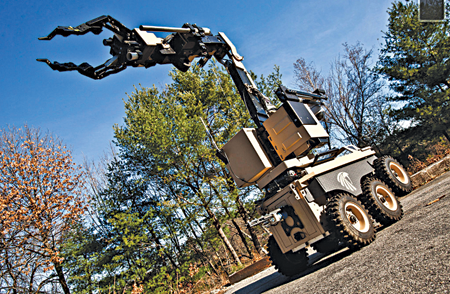
MARCH 2012: Arecent newspaper headline blared: “Humans lose, robots win in Pentagon’s new defence budget.” The story was about US president Obama’s decision to downsize the army by 100,000 soldiers in a move towards forming a lean but technologically-advanced army. He means to invest in electronic weapons to jam enemy defences and attack online networks, elite commando forces like the ones who rescued two aid workers kidnapped in Somalia, and more than 65 Predator and Reaper combat air patrols.
Predator, Reaper, LandShark, Armadillo, Snakebot… countries all over the world are going in for robot-helpers for their military forces. According to an ABI Research report released last year, around 50 to 80 countries are already using robotic defence systems, or are in the process of building or acquiring the technology to incorporate these into their military programmes.
These robots with the common purpose to replace or supplement humans in battlefields, may take the form of unmanned aerial vehicles (UAVs), unmanned ground vehicles (UGVs) and even unmanned underwater vehicles (UUVs). The report also predicts that the global market for military robotics will grow to more than $8 billion in 2016.
Soldiers and robots are indeed traversing warfronts side-by-side, and it appears that the trend is strengthening. We just hope they do not come face to face against each other some day, like Asimov’s bad dreams.
Marching ahead, unmanned
One of the main reasons for deploying robots on the warfront is to reduce injury and death of soldiers. This advantage obviously can be achieved only by unmanned robots. Several nations’ military forces have now started using unmanned vehicles for surveillance, detecting and detonating landmines and bombs, and traversing tough geographic and weather conditions. There are many such aerial, ground and underwater systems present today, but these are still a nascent technology and usually deployed in association with manned vehicles or human control.
“A perfect example of this is shown in the movie The Hurt Locker. The movie shows well how such robots are being used in defence. It is safe to say that both manned and unmanned vehicles are used in collaboration in the defence sector,” says Praveen Pitchai, who is working towards a masters degree in robotics at the University of Pennsylvania. He is also part of a team working on building a tele-operated/autonomous rover for a NASA competition.
Pitchai explains that there is a lot of work being done with regard to UAVs like the Predator, which is used by many countries for surveillance purpose. Last year, the US Air Force took into consideration the risks taken by soldiers during re-supply missions and started using an unmanned helicopter—K-MAX built by Lockheed Martin—in places like Afghanistan.
As far as ground robots are concerned, there is still a lot of work going on in this area. But for the purpose of defence, the robots are mainly used in a tele-operational capacity. This is because tele-operated robots are more easily con-trolled in missions like bomb diffusion.
“There certainly may be a time when unmanned vehicles rule the day, but not for a few decades to come as reliability is a prime concern and such technologies are still in their nascent stages of development,” says Pitchai.
T. Jayakrishnan, an experienced roboticist and consultant to US-based robotics companies, also agrees with the benefits of unmanned robotic systems. “Unmanned robots are particularly helpful for detecting hazards such as roadside bombs and chemical-biological threats. Using robots means that people can remain at a safe distance while they check a road or building for hazards,” he says.
Some of the unmanned robots that Jayakrishnan admires are Armadillo (a micro-UGV that can be thrown) and LandShark (a mid-size UGV). The latter features an open platform for multiple payloads (sensors, arm, digger, etc), tows 200 kg or lifts 70 kg with a heavy-lift arm, and can carry and drop-off/retrieve multiple micro-UGVs. Jayakrishnan also brings to notice the Oshkosh M-ATV, which is a manned or unmanned larger vehicle for rescue and cargo.
[stextbox id=”info” caption=”Defence robotics at a glance”]Push factors:
• Strong desire to reduce or prevent military casualties in the field of operations
• Changes in the tactics of warfare requiring new reconnaissance
• Combat, task machinery and tools
• The need to reduce military spending Developments in the fields of materials science, computer programming and sensing technology to help create more advanced robots
Pull factors:
• Weak economic conditions
• Dearth of active military conflicts for most of the world, which reduces the need for new defence systems
• Ethical concerns involving the use of robots for war-fighting operations
—Adapted from an ABI Research report titled “Defense Robots: UAVs, UGVs, UUVs and
Task Robots for Military Applications”[/stextbox]






